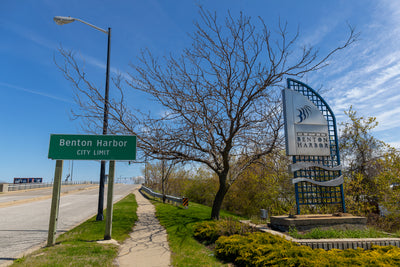Income, Race, and The Availability of Safe Drinking Water in Two Michigan Cities
RSS
Analies Dyjak, M.A. | Head of Policy and Perspectives
Governor Gretchen Whitmer recently called on the Federal Government to assist a community in Michigan struggling with unsafe lead levels in drinking water. Benton Harbor is located on Lake Michigan and has violated the Safe Drinking Water Act on numerous occasions in the past 6 years. Benton Harbor and neighboring St. Joseph combine to form what locals call the “twin cities.” Both of these communities are almost identical in total area and population size, but differ tremendously when it comes to race, economics, and access to safe drinking water.
Racial and Economic Disparities in Benton Harbor, Michigan
43% of families in Benton Harbor live below the poverty line, compared to only 6% of families in neighboring St. Joseph. Likewise, Benton Harbor is predominantly Black or African American (84.72%) and St. Joseph is predominantly White (83.87%). The median household income in Benton Harbor is $21,916, as compared to $62,374 in St. Joseph. These economic disparities impact everything from schools to housing to access to healthcare and to clean drinking water.
How High Are Lead Levels in Benton Harbor?
The highest level of lead detected in Benton Harbor was 440 parts per billion at the end of 2020. This is 29 times higher than the allowed level of lead in U.S. tap water, or what is referred to as the 15 part per billion Action Level (AL). The 90th percentile average of these samples were at or below 24 parts per billion, which is still well over the federal AL. For a bit of context, 90% of the samples in neighboring St. Joseph were 9 parts per billion - which is still higher than what’s recommended by most health agencies, but significantly lower than Benton Harbor’s lead levels. Officials in Benton Harbor also failed to test for PFAS, violating recent state-mandated testing requirements. PFAS are known to cause cancer, increased cholesterol, an increased risk of miscarriages, and other harmful health impacts.
What We Know About How Lead Impacts Children:
Lead is a neurotoxin and can cause lifelong irreversible damages to brain development. Children don’t have a fully developed blood-brain barrier making it easier for certain unwanted substances to cross into the Central Nervous System. Perhaps the most alarming impact that lead can have on young children is that lead can be mistaken for calcium, which is vital for bone growth and development. When this occurs, the body absorbs lead as it would calcium in the brain, blood, bones, and soft tissue. Long term health impacts of childhood exposure to lead include delayed growth and development, learning and behavioral problems, lowered IQ, attention deficit, hearing and speech problems, and underperformance in schools. The American Academy of Pediatrics has determined that there is no safe level of lead for children, and that any amount of lead in the system could result in negative health outcomes.
Our Take:
The impacts of lead on these already disadvantaged children exacerbate the many issues that they face. They often begin school already behind their counterparts “across the bridge”, and when subjected to the dangerously high lead levels, are at much higher risk for developmental delays. It’s obvious that lead is an issue in both of these communities, and this has likely been the case for decades. The problem becomes much more apparent when race and income become the defining factors in two almost identical cities.
Hydroviv's Charitable Partnership With Little Miss Flint
Hydroviv’s partnership with Little Miss Flint helps communities like Benton Harbor find immediate solutions. We’re able to donate our own NSF certified water filters to families who need them. Mari Copeny (commonly known as Little Miss Flint) helped to donate over one million bottles of water to families in Flint impacted by the 2014 water crisis. Hydroviv’s Scientific Founder, Dr. Eric Roy, started developing high-capacity lead removal filters to donate to child-centric organizations in Flint. This is where we met Mari and decided to form a partnership to address water quality issues together. So far we’ve donated hundreds of filters to communities in Wilmington, North Carolina, Memphis, Tennessee, Chicago, Illinois, and more. To learn more about our charitable efforts or to donate, click here.
Other Articles You May Be Interested In:
Lead Contamination in Flint, MI Drinking WaterNRDC's Latest Nationwide Lead Report -- Is your community at risk?
We're Finding PFAS Everywhere We Look




